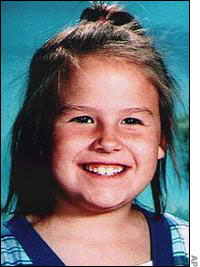By Seamus McGraw
 |
| Megan Kanka |
(Continued) Debate over Megan's Law rekindled by notorious cases
The killings have, in some quarters, rekindled the debate about the effectiveness of sex offender notification laws, collectively known as "Megan's Law" after Megan Kanka, the seven-year-old New Jersey girl who was raped and killed a decade ago by a repeat offender who lived in her neighborhood. Ironically, Jesse Timmendequas, the ex-convict who is now awaiting execution on New Jersey's death row for Megan's slaying would not have been required to register had that state's law been in effect when the crime was committed. Still, the laws have been hailed by politicians and supporters who insist that they give police and parents critical information about potential predators living in their midst.
 |
| Jesse Timmendequas |
But the sex offender notification laws have also drawn fire from critics, many of them professionals who study sex crimes and the people who commit them, who contend that while there is a hard-core minority of compulsive predators, overall, recidivism rates among most sex offenders are actually lower than for other class of criminals. According to a 2003 report from the federal Bureau of Justice Statistics, 43 percent of sex offenders, including child molesters, are rearrested for any crime within three years of their release, as opposed to 68 percent for all other offenders. Not surprisingly, though, the study also shows that when sex offenders are rearrested, they are about four times more likely than other offenders to be charged with a sex crime.
There is, the experts say, no question that there are dangerous sexual predators in the United States and elsewhere, who will never respond to treatment, and need desperately to be incarcerated and contained. Several states have begun experimenting with civil commitments which target the worst among them for lengthy, sometimes lifelong institutionalization in facilities geared specifically to hold them. There is widespread support for such operations, even among those who routinely treat sex offenders.
But those most dangerous predators are, say experts and according to law enforcement statistics, only a small minority of those who sexually abuse children. They are among the 5.3 percent of convicted sex offenders who are rearrested within 36 months for another sex crime.
Few voices, if any, object to severe penalties for those repeat offenders. In fact, even some of the most vocal critics of existing sex offender laws, including Freeman-Long support things like civil commitment.
But the problem, the experts say, is that often, the laws that are designed to stop the monsters are over broad, and do little to distinguish between habitual, violent and dangerous offenders, and those who, responding to incarceration and treatment, are more likely to control their impulses.
There are mechanisms available to draw those distinctions. Risk management assessment tools have become more precise in recent years. But scant resources have not been focused in that direction, critics say. Instead, in many cases, the focus, understandably, has been on punishment and on what some critics describe as "one size fits all" penalties for sex offenses.
And that may have a downside, critics warn. Statistically, the vast majority of sex crimes against children occur within the family or in the close community, and in many of those cases, particularly in cases involving young children, they are solved when the suspect confesses or agrees to plea bargain. That gives the state the authority to intervene, the critics say, and can often lead to steps that prevent the suspect from offending again.
But critics fret that increasingly punitive penalties, plus the threat of vigilante violence runs the risk of making those potentially reclaimable offenders, less likely to cooperate with authorities.
Some have also suggested that because so many victims of sex crimes are children, often with complex and contradictory emotional attachments to their abusers who have to be coaxed into talking about their ordeal many, authorities suspect, never do — the one size fits all approach to sex offenders may make them even less likely to name their abusers.
If greater attention was paid to separating the dangerous compulsive and repetitive offenders from those who could be rehabilitated, states could then more effectively target their responses, devoting their resources to containing the monsters and treating those who would benefit from incarceration and treatment.
Because of the nature of sex crimes, which are sometimes heinous and always deeply disturbing, far more so than property crimes like robbery, they often provoke the most severe response from the public and from lawmakers. The problem is that the legislation that often follows such cases is at best an exercise in wishful thinking and is frequently counterproductive, they say.
Though every state in the union now requires convicted sex offenders to register with local officials, and in many cases make public the names and addresses of the convicts, often, the most dangerous offenders fail to comply, either giving false addresses or moving without notifying authorities. The upshot is that while residents may know about the presence of a compliant sex offender, they will have no idea that a more dangerous potential predator is living among them and there is a danger that people will get a false sense of security. And even when sex offenders are where they're supposed to be, the laws do little to prevent violence against children, critics say. The slaying last year of Jessica Lunsford in Florida is a case in point, says Robert Freeman-Longo, a nationally recognized expert in the treatment of sex offenders. In that case, authorities ultimately charged a convicted pedophile, John E. Couey her rape and murder. A month later, another child, 13-year-old Sarah Lunde, was found dead and another sex offender was charged with her murder.
 |
| Jessica Lunsford |
Those cases, Freeman-Longo says, "are all the more proof that these laws don't do anything to protect anybody."
Next Page
Previous Page
For more daily crime news




